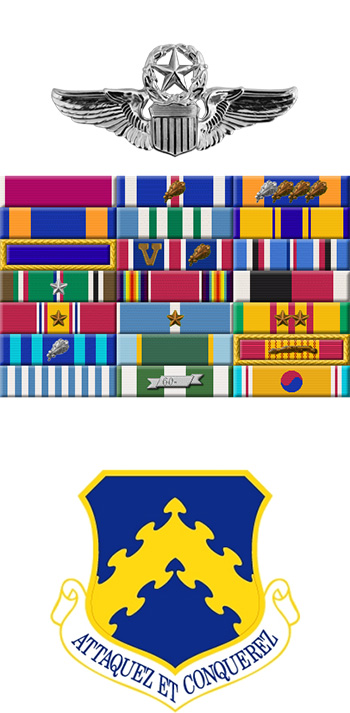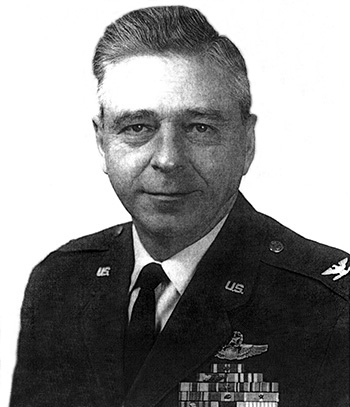
|
David J. Schmerbeck |
 |
|||
| Rank, Service | ||||
Colonel O-6, U.S. Air Force |
||||
| Veteran of: | ||||
|
||||
| Tribute: | ||||
David Schmerbeck was born on January 8, 1922, in Altoona, Pennsylvania. He enlisted in the U.S. Army Reserve on July 20, 1942, and entered the Aviation Cadet Program of the U.S. Army Air Forces on January 30, 1943, receiving his commission as a 2d Lt and his pilot wings on November 3, 1943. Lt Schmerbeck next completed P-47 Thunderbolt transition training before serving as a P-47 and then P-51 Mustang pilot with the 319th Fighter Squadron of the 325th Fighter Group in North Africa and Italy during World War II, where he was credited with the destruction of 3 enemy aircraft in aerial combat. Capt Schmerbeck left active duty and served in the Air Force Reserve from August 1, 1945, until he was recalled to active duty on November 18, 1947. His next assignment was as a Ground Safety Officer and then as a Personnel Equipment Officer at Chanute AFB, Illinois, from November 1947 to April 1949, followed by service as Base Training Officer and then Assistant Base Operations Officer with the 3345th Technical Training Wing at Chanute AFB from April 1949 to May 1950. Maj Schmerbeck received an Air Force Institute of Technology assignment to the University of Illinois to complete his bachelor's degree from May to September 1950, and then served as Assistant Base Operations Officer, Operations and Training Staff Officer, and then as Tactical Inspector for the 374th Air Base Group and the 374th Troop Carrier Wing in Japan and Korea from September 1950 to April 1952. His next assignment was on the staff of Headquarters Continental Air Command at Mitchel AFB, New York, from April 1952 to July 1955, where he served as Chief of the Publications Branch, Director of Reserve Training, and then as Education and Training Staff Officer. He received another Air Force Institute of Technology assignment, this time to George Washington University, from July 1955 to August 1956, followed by B-47 Stratojet Combat Crew Training from August to October 1956. LtCol Schmerbeck served as a B-47 pilot and Operations Officer with the 360th Bomb Squadron at Davis-Monthan AFB, Arizona, from November 1956 to October 1959, and then as a B-47 pilot and Commander of the 359th Bomb Squadron at Davis-Monthan from October 1959 to May 1960. His next assignment was as a Control Officer and then as Chief of the Current Operations Section with Headquarters Strategic Air Command at Offutt AFB, Nebraska, from May 1960 to December 1963, followed by service as a Project Officer in the Policy and Doctrine Division in the Office of the Joint Chiefs of Staff in the Pentagon from January 1964 to July 1967. Col Schmerbeck served as Director of the 3rd Air Force Command Post at Ruislip AS, England, from July 1967 to July 1968, and then as an F-4 Phantom II pilot and Deputy Commander for Operations of the 81st Tactical Fighter Wing (TFW) at RAF Bentwaters, England, from July 1968 to March 1969. He served as Vice Commander of the 81st TFW from March to August 1969, and as Commander from August 1969 to March 1970. Col Schmerbeck's final assignment was as Commander of the 8th Tactical Fighter Wing at Ubon Royal Thai AFB, Thailand, from May 1970, until he died of a heart attack upon landing his F-4 at Ubon on October 2, 1970. His remains were flown back to the United States and he was buried at Arlington National Cemetery. |
||||
|
||||

